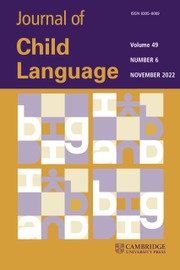Article contents
There might be more to syntactic bootstrapping than being pragmatic: A look at grammatical person and prosody in naturalistic child-directed speech
Published online by Cambridge University Press: 09 March 2023
Extract
In ‘Being pragmatic about syntactic bootstrapping’, Hacquard (2022) argues that abstract syntax is useful for word learning, but that an additional cue, pragmatics, is both necessary and available for young children during the first steps of language acquisition. She focuses on modals and attitude verbs, where the physical context seems particularly impoverished as the sole basis for deriving meanings, and thus where linguistic cues may be particularly helpful. She convincingly shows how pragmatic and syntactic cues could be combined to help young language learners learn and infer the possible meanings of attitude verbs such as “think”, “know” or “want”. She also argues that, in some circumstances, syntax and pragmatics would need to be supplemented by semantic information from context – for instance, in the case of modals such as “might”, “can”, or “must”. We agree with Hacquard on the importance of the synergies between these different cues to meaning, and wish to add two other aspects of the input that might also be used by young children in these contexts. The aspects we describe can only be noticed when one analyzes concrete examples of what children hear in their everyday lives, something which Hacquard does very often in her work (e.g., Dieuleveut, van Dooren, Cournane & Hacquard, 2022; Huang, White, Liao, Hacquard & Lidz, 2022; Yang, 2022). Taking into account different cues for meaning would help the field go beyond current models of syntactic bootstrapping, and create an integrated picture of the synergies between different levels of linguistic information.
Information
- Type
- Invited Commentary
- Information
- Journal of Child Language , Volume 50 , Issue 5: Special Issue on Syntactic Bootstrapping , September 2023 , pp. 1074 - 1078
- Copyright
- © The Author(s), 2023. Published by Cambridge University Press
Footnotes
Joint first authors
References
- 1
- Cited by


